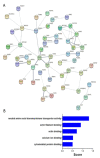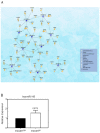Comprehensive Transcriptome and Pathway Analyses Revealed Central Role for Fascin in Promoting Triple-Negative Breast Cancer Progression
- PMID: 34959629
- PMCID: PMC8708558
- DOI: 10.3390/ph14121228
Comprehensive Transcriptome and Pathway Analyses Revealed Central Role for Fascin in Promoting Triple-Negative Breast Cancer Progression
Abstract
Recent years have witnessed major progress in development of novel therapeutic agents such as chemotherapy, targeted therapy and immune checkpoint inhibitors for breast cancer. However, cancer-related death remains high especially in triple-negative breast cancer (TNBC) due limited therapeutic options. Development of targeted therapies for TNBC requires better understanding of biology and signaling networks that promote disease progression. Fascin, an actin bundling protein, was identified as a key regulator of many signaling pathways that contribute to breast cancer progression. Herein, fascin ShRNA was used to generate stable fascin knockdown (FSCN1KD) in the MDA-MB-231 TNBC cell line and then were subjected to comprehensive mRNA and miRNA transcriptome analysis. We identified 129 upregulated and 114 downregulated mRNA transcripts, while 14 miRNAs were differentially expressed in FSCN1KD. Ingenuity pathway analysis (IPA) was used to predict the impact of differentially expressed transcripts on signaling pathways and functional categories and to construct miRNA-mRNA regulatory networks in the context of FSCN1 knockdown. Compared to FSCN1KD, fascin-positive (FSCN1CON) breast cancer cells showed enrichment in genes promoting cellular proliferation, migration, survival, DNA replication and repair. Expression of FSCN1high (identified in BRCA dataset from TCGA) in conjunction with elevated expression of the top 10 upregulated or decreased expression of the top 10 downregulated genes (identified in our FSCN1CON vs. FSCN1KD) correlates with worst survival outcome. Taken together, these data confirmed fascin's role in promoting TNBC progression, and identified a novel opportunity for therapeutic interventions via targeting those FSCN1-related transcripts.
Keywords: IPA; breast cancer; fascin; miRNA; pathway analysis; transcriptome.
Conflict of interest statement
The authors declare no conflict of interest.
Figures








Similar articles
-
Comparative Analysis of Breast Cancer Metabolomes Highlights Fascin's Central Role in Regulating Key Pathways Related to Disease Progression.Int J Mol Sci. 2024 Jul 18;25(14):7891. doi: 10.3390/ijms25147891. Int J Mol Sci. 2024. PMID: 39063133 Free PMC article.
-
Fascin actin-bundling protein 1 regulates non-small cell lung cancer progression by influencing the transcription and splicing of tumorigenesis-related genes.PeerJ. 2023 Dec 5;11:e16526. doi: 10.7717/peerj.16526. eCollection 2023. PeerJ. 2023. PMID: 38077434 Free PMC article.
-
EGFR conjunct FSCN1 as a Novel Therapeutic Strategy in Triple-Negative Breast Cancer.Sci Rep. 2017 Nov 15;7(1):15654. doi: 10.1038/s41598-017-15939-9. Sci Rep. 2017. PMID: 29142206 Free PMC article.
-
The role and regulatory mechanism of FSCN1 in breast tumorigenesis and progression.Yi Chuan. 2023 Feb 20;45(2):115-127. doi: 10.16288/j.yczz.22-346. Yi Chuan. 2023. PMID: 36927659 Review.
-
Fascin actin-bundling protein 1 in human cancer: promising biomarker or therapeutic target?Mol Ther Oncolytics. 2021 Jan 20;20:240-264. doi: 10.1016/j.omto.2020.12.014. eCollection 2021 Mar 26. Mol Ther Oncolytics. 2021. PMID: 33614909 Free PMC article. Review.
Cited by
-
Comparative Analysis of Breast Cancer Metabolomes Highlights Fascin's Central Role in Regulating Key Pathways Related to Disease Progression.Int J Mol Sci. 2024 Jul 18;25(14):7891. doi: 10.3390/ijms25147891. Int J Mol Sci. 2024. PMID: 39063133 Free PMC article.
-
Identification of novel molecules and pathways associated with fascin actin‑bundling protein 1 in laryngeal squamous cell carcinoma through comprehensive transcriptome analysis.Int J Mol Med. 2024 Apr;53(4):39. doi: 10.3892/ijmm.2024.5363. Epub 2024 Mar 1. Int J Mol Med. 2024. PMID: 38426543 Free PMC article.
-
Inhibitors of the Actin-Bundling Protein Fascin-1 Developed for Tumor Therapy Attenuate the T-Cell Stimulatory Properties of Dendritic Cells.Cancers (Basel). 2022 May 31;14(11):2738. doi: 10.3390/cancers14112738. Cancers (Basel). 2022. PMID: 35681718 Free PMC article.
-
Identification of a Gene Panel Predictive of Triple-Negative Breast Cancer Response to Neoadjuvant Chemotherapy Employing Transcriptomic and Functional Validation.Int J Mol Sci. 2022 Sep 17;23(18):10901. doi: 10.3390/ijms231810901. Int J Mol Sci. 2022. PMID: 36142814 Free PMC article.
References
-
- Balduzzi A., Bagnardi V., Rotmensz N., Dellapasqua S., Montagna E., Cardillo A., Viale G., Veronesi P., Intra M., Luini A., et al. Survival Outcomes in Breast Cancer Patients with Low Estrogen/Progesterone Receptor Expression. Clin. Breast Cancer. 2013;14:258–264. doi: 10.1016/j.clbc.2013.10.019. - DOI - PubMed
-
- Dellapasqua S., Bagnardi V., Balduzzi A., Iorfida M., Rotmensz N., Santillo B., Viale G., Ghisini R., Veronesi P., Luini A., et al. Outcomes of patients with breast cancer who present with ipsilateral supraclavicular or internal mammary lymph node metastases. Clin. Breast Cancer. 2014;14:53–60. doi: 10.1016/j.clbc.2013.09.008. - DOI - PubMed
Grants and funding
LinkOut - more resources
Full Text Sources
Miscellaneous

